Poa trivialis
Explore More :
Explore plus :
Overview
Aperçu
Regulation :
Remarques Réglementation:
- USA Federal Noxious Weed Seed List
Regulation Notes:
Classified as a noxious weed seed or undesirable grass species when found as a contaminant in grass seed marketed for lawn or turf purposes in certain US states (Delaware, Maryland, New Hampshire, New Jersey, Pennsylvania, Virginia, and West Virginia) (USDA-AMS 2022b).
Distribution :
Répartition :
Is native to Eurasia including areas of Northern Africa and Macaronesia, Temperate Asia, Tropical Asia (mainly the Indian subcontinent) and Europe (USDA-ARS 2022).
Poa trivialis has been introduced and naturalized in South Africa, Australia, New Zealand, Canada, USA and Chile and is adventive in Argentina and Uruguay (Edgar and Connor 2000; USDA-ARS 2022).
Habitat and Crop Association :
Habitat et Cultures Associées :
Poa trivialis invades landscapes, roadsides, meadows, waste areas, moist and disturbed areas (UCIPM 2016; Patton & Beck 2022). It is primarily considered a turfgrass weed but can also invade fields of Medicago sativa (alfalfa) (UCIPM 2016; Patton & Beck 2022).
Economic Use, cultivation area, and Weed Association :
Utilisation économique, zone de culture et association de mauvaises herbes :
Poa trivialis is used as a cool-season turf and pasture grass species (Alderson and Sharp 1995; Barkworth et al. 2007).
Duration of Life Cycle :
Durée du cycle vital:
Perennial
Dispersal Unit Type :
Type d’unité de dispersion :
Spikelet, floret
General Information
RENSEIGNEMENTS GÉNÉRAUX
Poa trivialis is a cool-season, shade tolerant, perennial grass crop species that spreads both by seed and by stolons (creeping above ground stems that can produce new plants when they come into contact with soil) forming dense tufts (UCIPM 2016; Abbey 2019; Virginia Tech 2020). This species is used for turf and pasture in northern latitudes and for winter overseeding of warm-season grasses in warmer areas (Alderson and Sharp 1995; Virginia Tech 2020).
In commercial seed markets, P. trivialis is sometimes purposefully mixed with P. pratensis (Kentucky bluegrass) or P. compressa (Canada bluegrass). However, P. trivialis can become a weedy pest and for this reason several US states declare it a noxious undesirable grass species when found as a contaminant in commercially sold lawn seed (USDA-AMS 2022b).
.Identification
Identification
-
Spikelet
Size
- Spikelet length: 2.3 – 3.5 (4) mm (Barkworth et al. 2007, eFloras 2022).
Shape
- Spikelet shape oblong-oval, laterally compressed.
Surface Texture
- Spikelet surface texture papery with short stiff hairs.
Colour
- Spikelet colour light brown
Other Features
Spikelet composition
- Multiple floret spikelet with 2 – 4 similar looking florets (Douglas et al. 2001).
Glumes
- Glumes thin and papery.
- Glume keels with short stiff hairs.
- Lower glume length 1.5 – 2 mm, narrow, often sickle-shaped, 1-nerved (Douglas et al. 2001; eFloras 2022).
- Upper glume length 2.2 – 3 mm, 3-nerved (eFloras 2022).
Disarticulation
- Spikelet disarticulation generally occurs above glumes and between florets at rachilla nodes, although intact spikelets can be occasionally found in commercial seed lots.
-
Floret
Size
- Floret length*: 1.9 – 2.9 mm (average 2.4 mm); width*: 0.5 – 0.7 mm (average 0.6 mm); thickness*: 0.5 – 0.7 mm (average 0.6 mm).
- Rachilla length*: 0.1 – 0.8 mm (average 0.4 mm).
*Note: minimum and maximum size based 30 florets in normal range of this species using image measurement protocol (ISMA 2020). Length equals longest measurement of floret, width equals greatest measurement of floret in palea view, thickness equals greatest measurement of floret in lateral view. CDA-S-25063, CDA-S-25061, CDA-S-58601.
Size measurements from literature:
• Floret length: 2.8 mm; width: 0.5 – 0.7 mm (Bojňanský and Fargašová 2007).
• Lemma length: 2.3 – 3.5 mm (Barkworth et al. 2007).Shape
- Floret narrowly teardrop-shaped (lanceolate), sharply keeled, arched along the keel
Surface Texture
- Lemma and palea papery
Colour
- Floret colour light brown
Other Features
Lemma
- Lemma 5-nerved.
- Lemma strongly keeled and tightly adhering to the caryopsis.
- Lemma keel sparsely hairy in lower three-fifths.
- Marginal nerves with soft hairs in lower one-quarter.
- Lateral nerves prominent.
- Lemma surface between nerves without hairs.
- Lemma may appear oil soaked.
- Lemma tip tapered to a point and the margins are folded inward.
Awn
- Lemma without awn.
Callus
- Callus blunt, with long cobwebbed hairs on un-milled florets
Rachilla
- Rachilla slender, up to one-quarter the length of the floret.
- Rachilla surface smooth or with small sharp bumps.
Palea
- Palea with deep longitudinal crease.
- Palea keels smooth or with minute hairs (palea teeth).
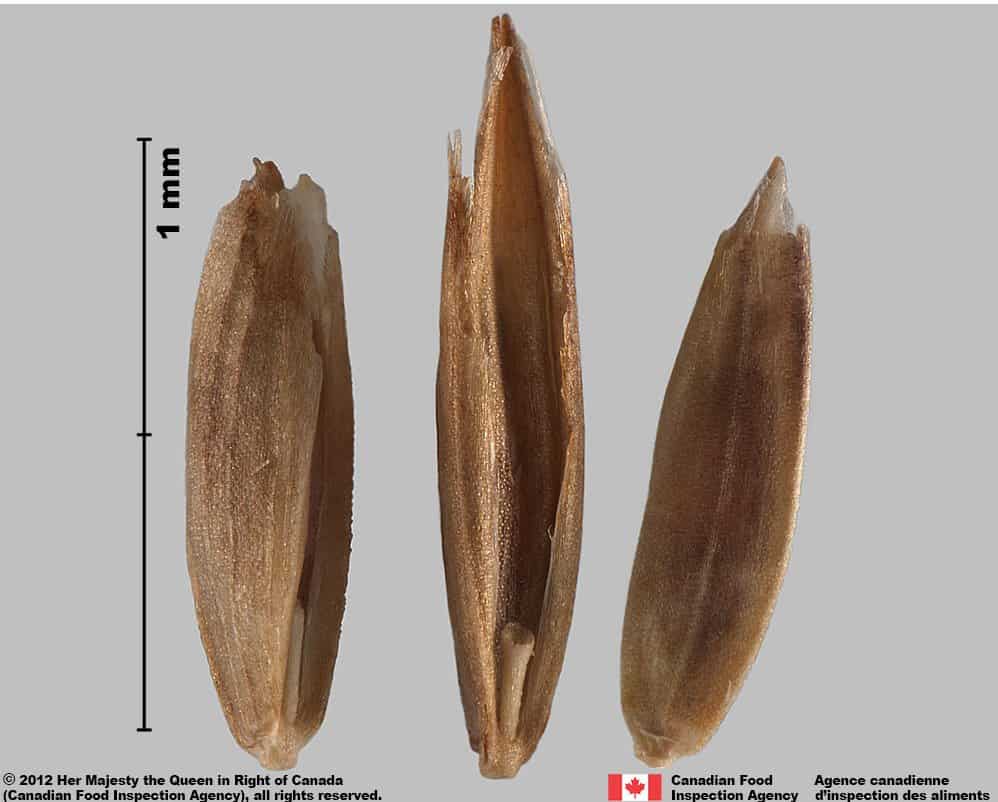
Rough bluegrass (Poa trivialis) florets





-
Caryopsis
Size
- Caryopsis length*: 1.1 – 1.6 mm (average 1.4 mm); width*: 0.4 – 0.6 mm (average 0.5 mm); thickness*: 0.4 – 0.6 mm (average 0.5 mm).
- Hilum length*: 0.07 – 0.19 mm (average 0.14 mm).
*Note: minimum and maximum size based 10 caryopses in normal range of this species using image measurement protocol (ISMA 2020). Length equals longest measurement of caryopsis, width equals greatest measurement of caryopsis in embryo view, thickness equals greatest measurement of embryo in lateral view. CDA-S-25063.
Caryopsis measurements from literature:
Caryopsis length: 1.5 – 1.8 mm; width: 0.4 – 0.6 mm (Bojňanský and Fargašová 2007).
Shape
- Caryopsis spindle-shaped, laterally compressed and triangular in cross-section, dorsal side with longitudinal depression.
Surface Texture
- Caryopsis surface smooth
Colour
- Caryopsis reddish brown coloured.
Other Features
- Hilum a small round spot located near base of caryopsis on the side opposite the embryo.
-
Embryo
Size
- Embryo length*: 0.3 – 0.4 mm (average 0.4 mm).
- Embryo about one-quarter the length of caryopsis.
*Note: minimum and maximum size based 10 embryos in normal range of this species using image measurement protocol (ISMA 2020). CDA-S-25063.
Shape
- Embryo teardrop shaped.
Endosperm
- Endosperm solid (Terrell 1971).
Other Features
- Embryo position lateral (Martin 1946).
Identification Tips
CONSEILS POUR L’IDENTIFICATION
Several characters are key to separating Poa trivialis from other species of Poa. These include:
- Floret sharply keeled, lemma keel curved, lemma tip folded inward.
- Lemma sometimes looks like oil-soaked paper.
- Lemma nerves prominent.
- Hairs on palea keels (palea teeth) short, fine, closely spaced, and extending to palea tip.
- Caryopsis tightly enclosed by the lemma.
- Long cobweb-like hairs on the callus (may be missing on milled florets).

Rough bluegrass (Poa trivialis) floret, palea view





Additional Botany Information
AUTRES RENSEIGNEMENTS BOTANIQUES
Flowers/Inflorescence
- Panicles up to 25 cm long and 6 cm wide, oblong to pyramid shaped, open, upright or relaxed, with 3 – 7 branches per node and 5 – 35 spikelets per branch (Barkworth et al. 2007; Virginia Tech 2020).
Vegetative Features
- Plants loose to densely tufted, spreading via stolons, stems 25 – 120 cm tall, upright or trailing and rooting at nodes (Douglas et al. 2001; Barkworth et al. 2007).
Similar Species
ESPÈCES SEMBLABLES
Similar species are based on a study of seed morphology of various species, and those with similar dispersal units are identified. The study is limited by physical specimen and literature availability at the time of examination, and possibly impacted by the subjectivity of the authors based on their knowledge and experience. Providing similar species information for seed identification is to make users aware of similarities that could possibly result in misidentification.
Poa pratensis, P. compressa, and P. annua can be found as contaminants in seed lots of P. trivialis or other types of lawn, turf, and pasture grass seed lots. Key diagnostic features to separate florets these four species are included in the comparison table:
Comparison table of morphological characters of unmilled Poa florets.
| P. trivialis | P. pratensis | P. compressa | P. annua | |
| Floret shape | Lemma sharply keeled; keel curved.
Lemma tip folded inward. |
Lemma keeled, keel straight to slightly curved.
Lemma tip folded inward. |
Lemma and palea usually flared open at tip. | In lateral view the palea appears like a bulging belly.
Lemma tip folded inward or flared out. |
| Lemma | Papery, appearing oil soaked. | Papery | Papery | Papery with membranous margins. |
| Lemma nerves and keel | Marginal and lateral nerves and keel prominent, without hairs. | Lateral nerves prominent, usually without hairs.
Lower two-thirds of keel and marginal nerves with long soft hairs.
|
Lateral nerves obscure or lacking.
Lower two-thirds of keel and marginal nerves with long soft hairs.
|
Lateral nerves prominent. Keel, marginal and lateral nerves with long silky hairs in the lower half. |
| Palea keel hairs (palea teeth) | Short, fine, close-spaced, and extending to tip of palea | Short, coarse, wide-spaced, and not extending to tip of palea | Short, fine, close-spaced, and extending to tip of palea | Long, densely spaced, and not extending to tip of palea |
| Caryopsis | Caryopsis spindle shaped, tightly enclosed by lemma and palea. |
Caryopsis spindle shaped, loosely enclosed by lemma and palea. |
Caryopsis spindle shaped, loosely enclosed by lemma and palea. | Embryo pinched and beak-like.
Surface with fine-net-like texture. Caryopsis loosely enclosed by lemma and palea. |
| Callus hairs | Long & web-like | Long & web-like | Short & web-like | None |
Click to select species
Cliquez pour sélectionner les espèces
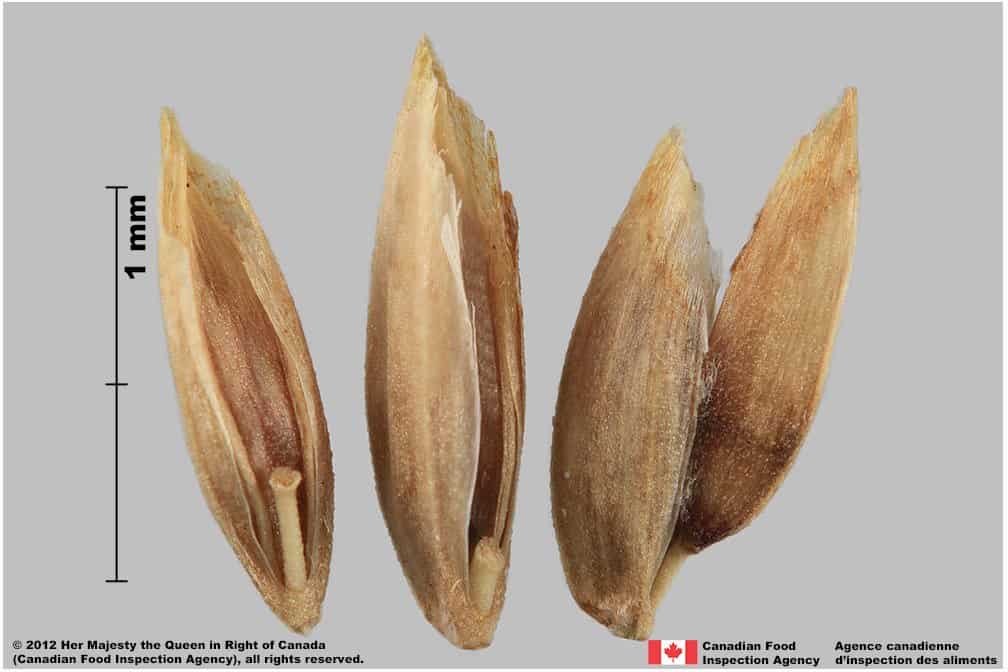
Poa pratensis
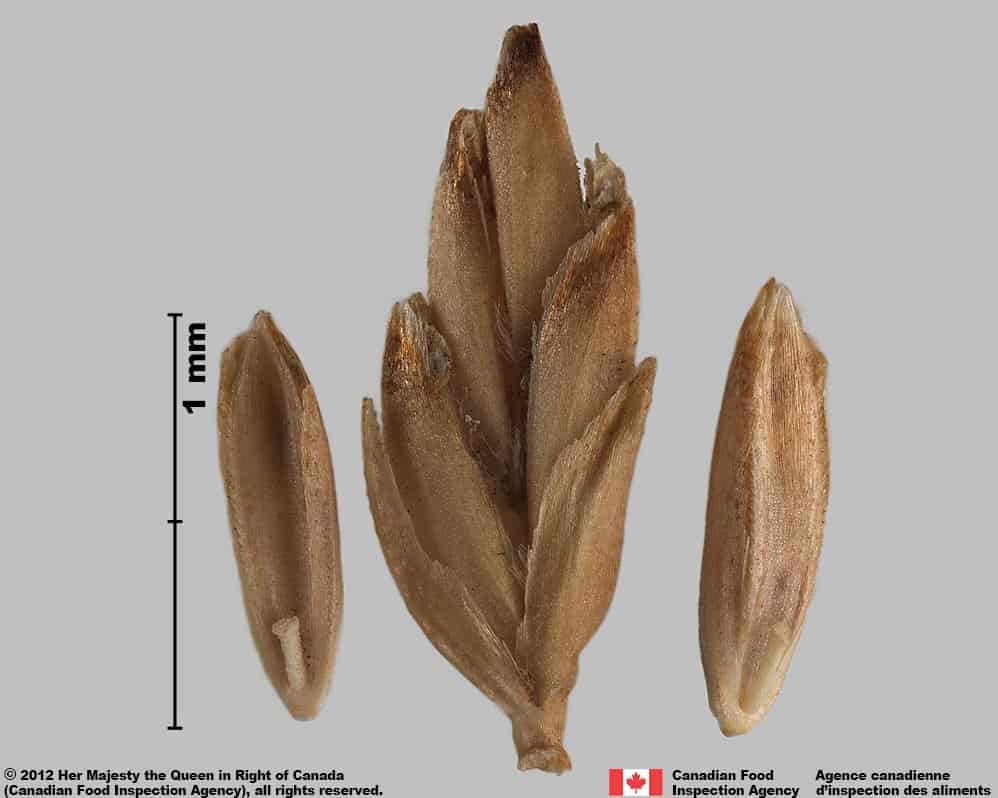
Poa compressa
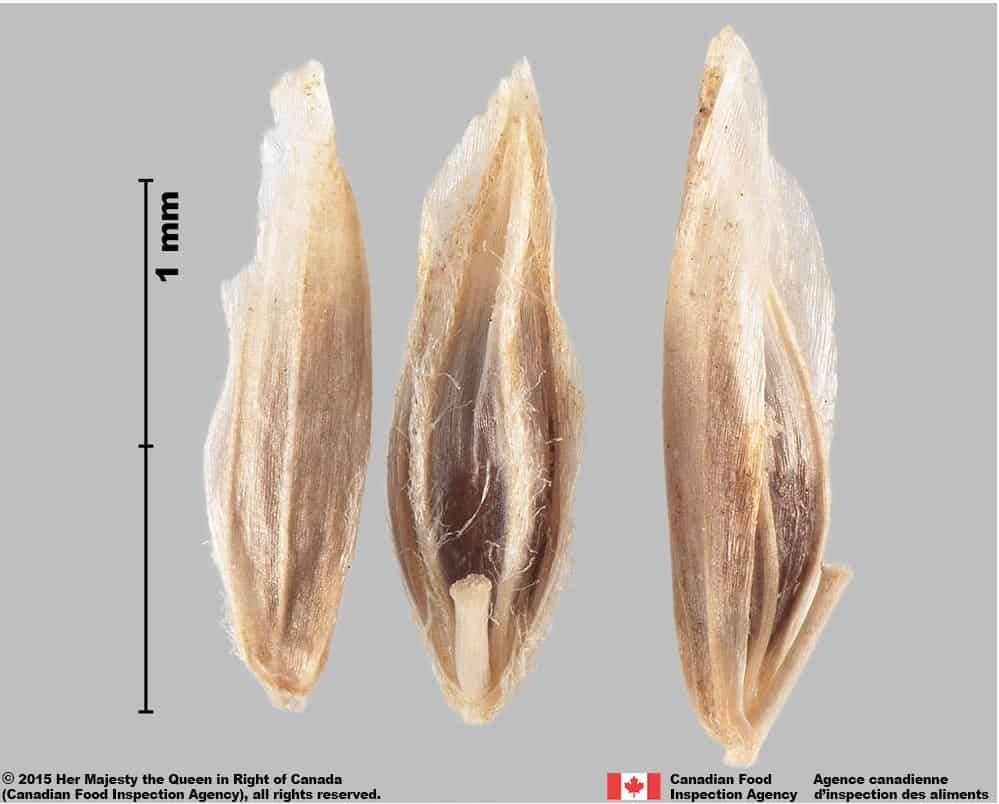
Poa annua
Comparison Window
Fenêtre de comparaison
MAIN SPECIES
ESPÈCES PRINCIPALES
Poa trivialis

Poa trivialis
Poaceae
Rough bluegrass (Poa trivialis) florets
MAIN SPECIES
ESPÈCES PRINCIPALES
Poa trivialis

Poa trivialis
Poaceae
Rough bluegrass (Poa trivialis) floret, palea view
MAIN SPECIES
ESPÈCES PRINCIPALES
Poa trivialis

Poa trivialis
Poaceae
Rough bluegrass (Poa trivialis) floret, side view
MAIN SPECIES
ESPÈCES PRINCIPALES
Poa trivialis

Poa trivialis
Poaceae
Rough bluegrass (Poa trivialis) floret, lemma view
MAIN SPECIES
ESPÈCES PRINCIPALES
Poa trivialis

Poa trivialis
Poaceae
Rough bluegrass (Poa trivialis) floret; close-up of rachilla
SIMILAR SPECIES
ESPÈCES SEMBLABLES
Poa pratensis

Poa pratensis
Poaceae
Kentucky bluegrass (Poa pratensis) florets
SIMILAR SPECIES
ESPÈCES SEMBLABLES
Poa pratensis
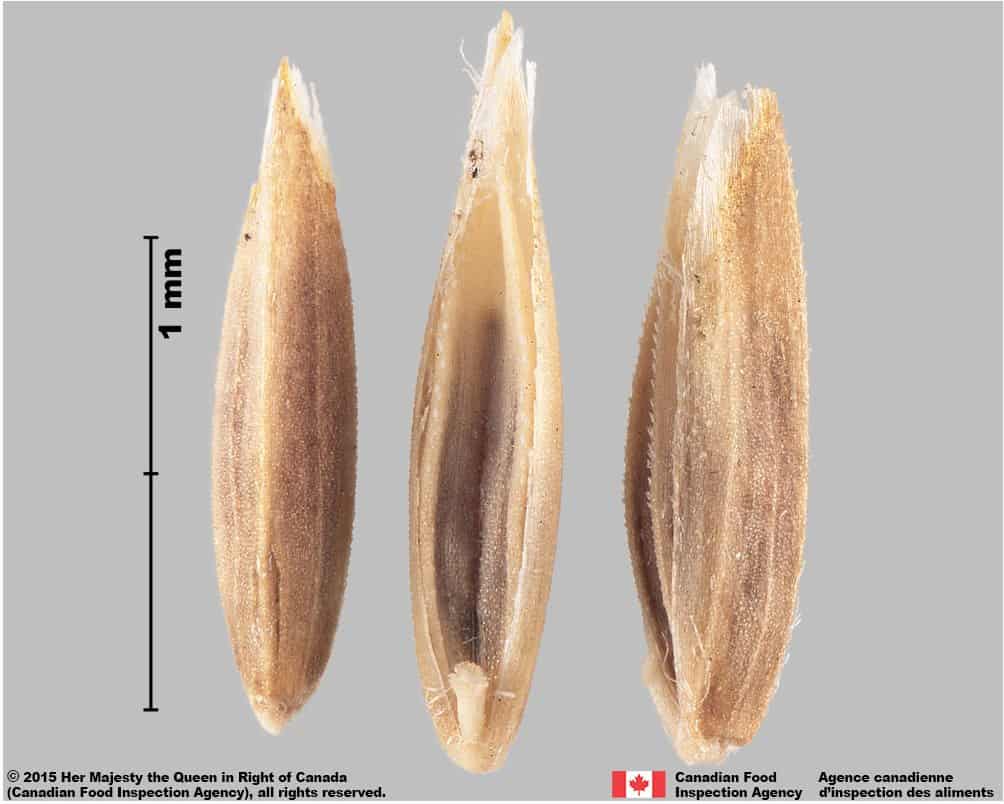
Poa pratensis
Poaceae
Kentucky bluegrass (Poa pratensis) florets
SIMILAR SPECIES
ESPÈCES SEMBLABLES
Poa pratensis
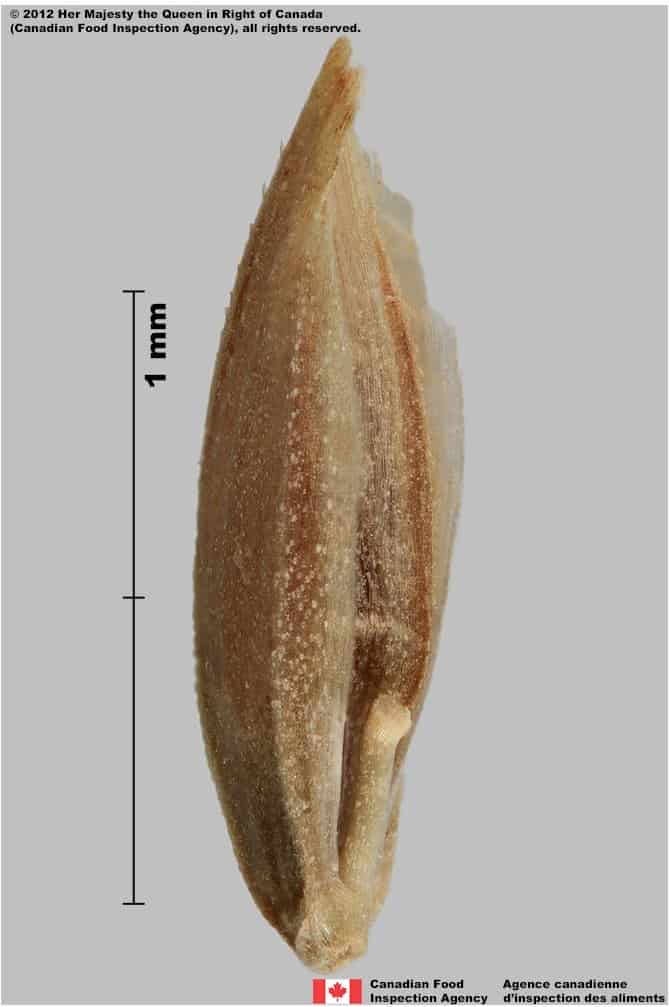
Poa pratensis
Poaceae
Kentucky bluegrass (Poa pratensis) floret, palea view
SIMILAR SPECIES
ESPÈCES SEMBLABLES
Poa pratensis
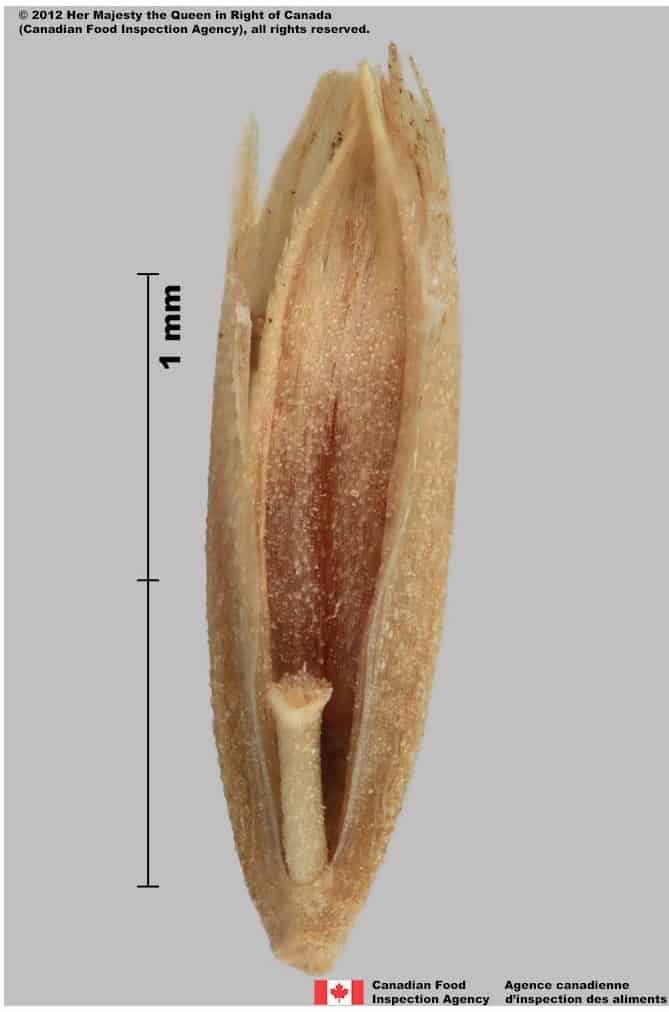
Poa pratensis
Poaceae
Kentucky bluegrass (Poa pratensis) floret, palea view
SIMILAR SPECIES
ESPÈCES SEMBLABLES
Poa pratensis
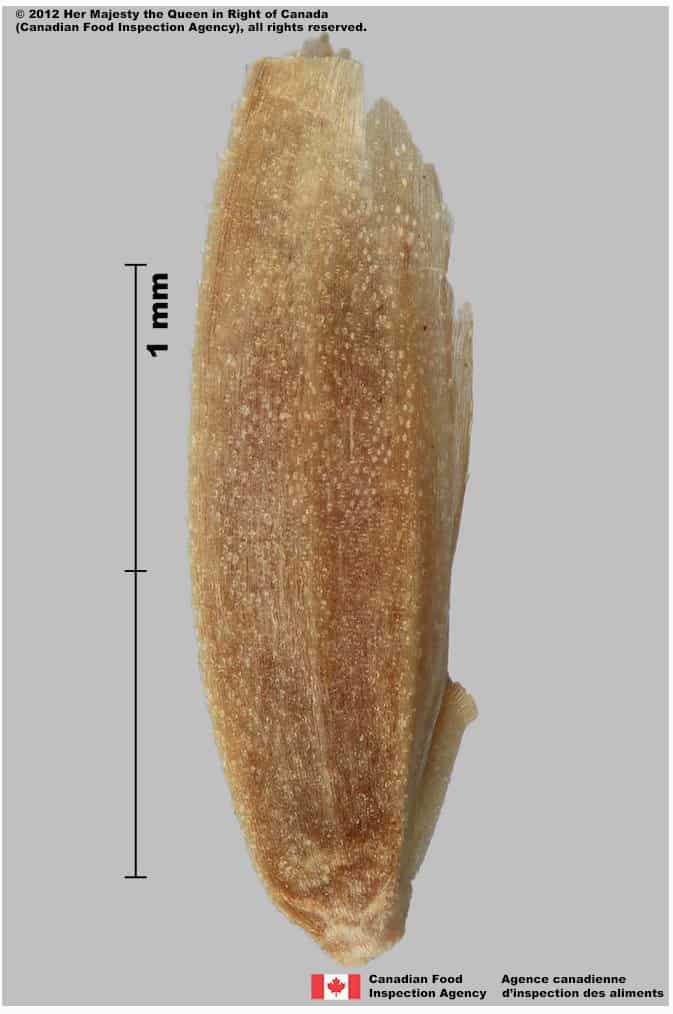
Poa pratensis
Poaceae
Kentucky bluegrass (Poa pratensis) floret, side view
SIMILAR SPECIES
ESPÈCES SEMBLABLES
Poa pratensis
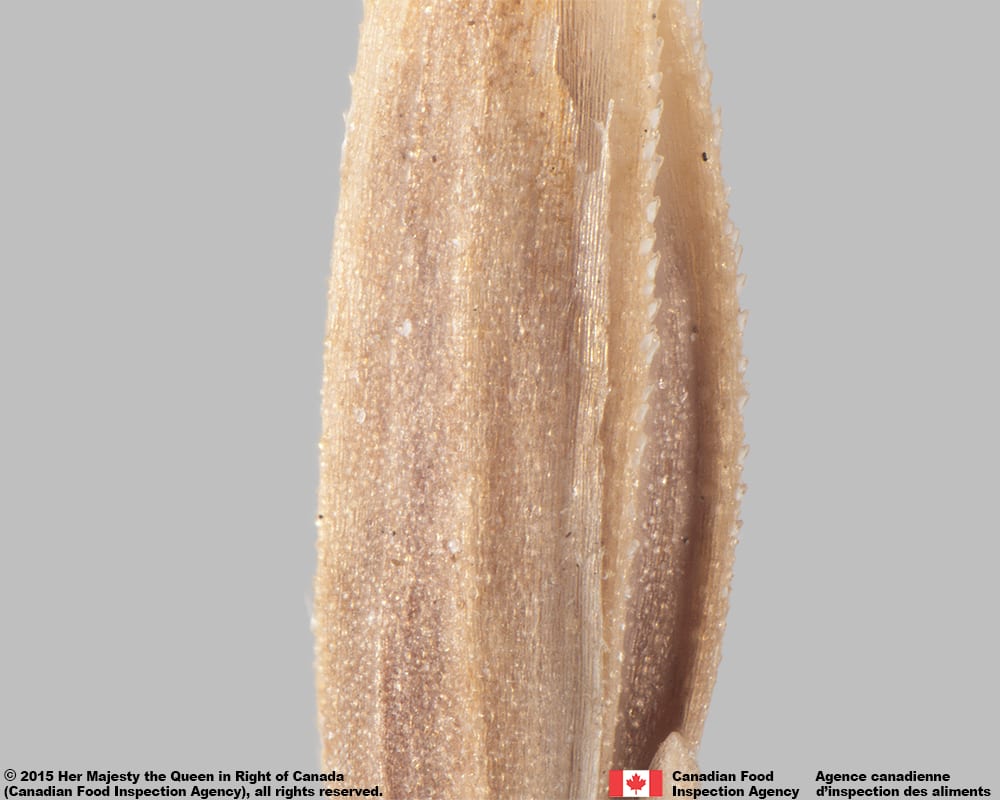
Poa pratensis
Poaceae
Kentucky bluegrass (Poa pratensis) floret, side view
SIMILAR SPECIES
ESPÈCES SEMBLABLES
Poa pratensis
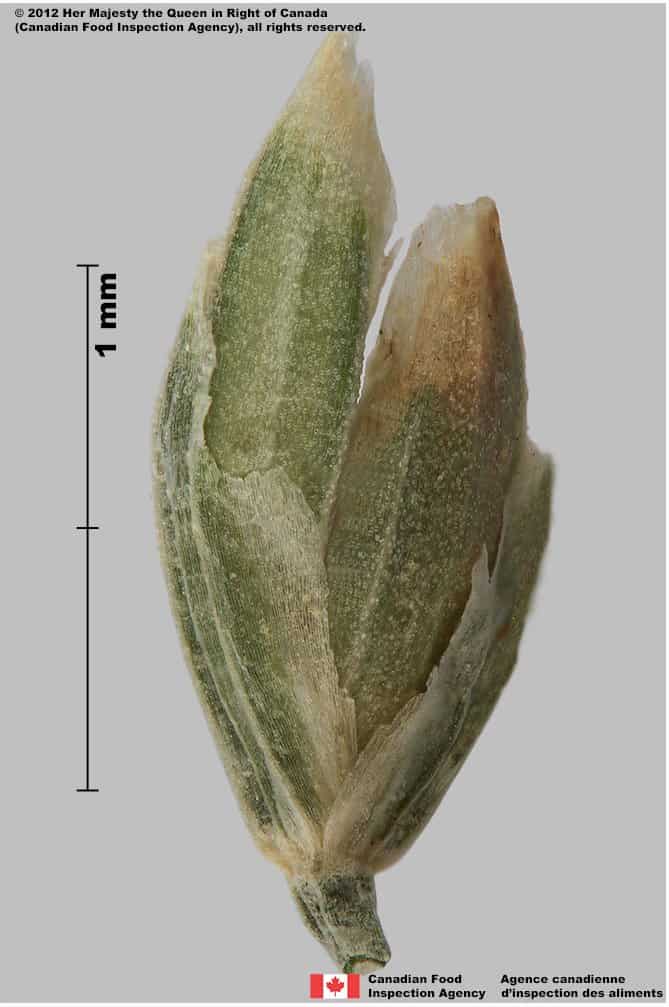
Poa pratensis
Poaceae
Kentucky bluegrass (Poa pratensis) spikelet
Need ID Help?
Besoin d’aide pour l’identification?
Reference(s)
Référence(s)
Abbey, T. (2019, March 21). Roughstalk Bluegrass: a Cool Season Perennial Grass. PennState Extension. https://extension.psu.edu/roughstalk-bluegrass-a-cool-season-perennial-grass. Accessed September 12, 2022.
Alderson, J. & W. C. Sharp. 1995. Grass varieties in the United States, U.S.D.A. Agric. Handbook 170, rev. ed. CRC Press.
Association of Official Seed Analysts (AOSA). 2022. Rules for Testing Seeds, Vol. 1: Principles and Procedures. Association of Official Seed Analysts, Washington D. C.
Barkworth, M. E., Capels, K. M., Long, S., and Piep, M. B. (eds.). 2007. Flora of North America Volume 24. Magnoliophyta: Commelinidae (in part): Poaceae, part 1. Oxford University Press, New York, New York.
Bojňanský, V. and Fargašová, A. 2007. Atlas of Seeds and Fruits of Central and East-European Flora: The Carpathian Mountains Region. Springer, Dordrecht, The Netherlands.
Canadian Food Inspection Agency (CFIA). 2023. Canadian Methods and Procedures for Testing Seeds (M&P). Version 1.1, English. Canadian Food Inspection Agency.
Douglas, G. W., Meidinger, D. and Pojar, J. (eds.). 2001. Illustrated Flora of British Columbia Vol. 7 Monocotyledons (Orchidaceae through Zosteraceae). British Columbia Ministry of Sustainable Resource Management and Ministry of Forests. p. 250. https://www.for.gov.bc.ca/hfd/pubs/docs/Mr/Mr106.pdf.
Edgar, E. and Conner, H. E. 2000. Flora of New Zealand. Vol. V. Gramineae. Manaaki Whenua Press. Lincoln, NZ.
eFloras. 2022. Flora of China. Poa trivialis. efloras.org Accessed December 13, 2022.
International Seed Morphology Association (ISMA). 2020. Method for seed size measurement. Version 1.0. ISMA Publication Guide. https://www.idseed.org/authors/details/method_for_seed_size_measurement.html.
International Seed Testing Association (ISTA). 1982. A multilingual Glossary of Common Plant-Names. 1. Field crops, grasses and vegetables, Ed. 2. International Seed Testing Association.
Martin, A. C. 1946. The comparative internal morphology of seeds. The American Midland Naturalist 36(3):513-660.
Musil, A. F. 1963. Identification of Crop and Weed Seeds. Agriculture Handbook No. 219. U. S. Department of Agriculture. Washington, D.C.
Patton, A. and Beck, L. 2022. Roughstalk Bluegrass. Turfgrass Science at Purdue University – Horticulture & Landscape Architecture, 625 Agriculture Mall, West Lafayette, IN 47907. https://turf.purdue.edu/roughstalk-bluegrass/. Accessed September 12, 2022.
Terrell, E. E. 1971. Survey of occurrences of liquid or soft endosperm in grass genera. Bull. Torr. Botan. Club 98(5):264-268.
University of California Statewide Integrated Pest Management Program (UCIPM). 2016. Roughstalk bluegrass (Poa trivialis). Division of Agriculture and Natural Resources, University of California. http://ipm.ucanr.edu/PMG/WEEDS/roughstalk_bluegrass.html. Accessed September 12, 2022.
United States Department of Agriculture-Agricultural Marketing Service (USDA-AMS). 2022a. Federal Seed Act Regulations. https://www.ecfr.gov/current/title-7/subtitle-B/chapter-I/subchapter-K/part-201 Accessed December 13, 2022.
United States Department of Agriculture-Agricultural Marketing Service (USDA-AMS). 2022b. State Noxious-Weed Seed Requirements Recognized in the Administration of the Federal Seed Act. https://www.ams.usda.gov/sites/default/files/media/StateNoxiousWeedsSeedList.pdf Accessed December 15, 2022.
United States Department of Agriculture-Agricultural Research Service-National Plant Germplasm System (USDA-ARS). 2022. Germplasm Resources Information Network (GRIN Taxonomy). National Germplasm Resources Laboratory, Beltsville, Maryland. https://npgsweb.ars-grin.gov/gringlobal/taxon/taxonomydetail?id=29023 Accessed December 14, 2022.
Virginia Tech. 2020. Rough bluegrass. Virginia Cooperative Extension Weed Identification. https://weedid.cals.vt.edu/profile/620. Accessed September 12, 2022.
Wiersema, J. H. and León, B. 1999. World Economic Plants: A Standard Reference. CRC Press, Boca Raton, FL.




